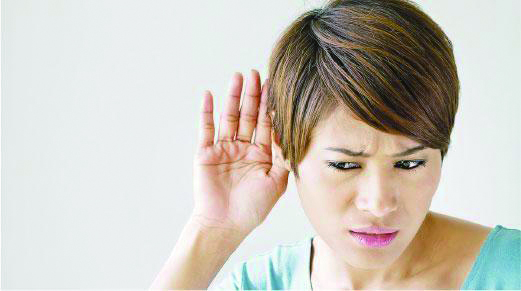Expert: Don’t wear noise-cancelling headphones for a long time, and be careful to damage your hearing
[ad_1]
Article: Zhang Shumei, “Ming Pao”
City noise is coming from all directions. In order to hear the music on the earphones clearly, it is easy to unconsciously turn up the volume. However, this may not be able to resist the ambient sound, but instead increases the risk of hearing damage!

(Hong Kong News) Noise-cancelling headphones can filter out environmental noise without amplifying the volume. The World Health Organization believes that noise-canceling headphones are a better choice.
However, some people experience tinnitus, ear pressure imbalance, dizziness, vomiting and other discomforts after wearing noise-cancelling headphones. Why is this happening?

The principle of noise reduction is divided into active and passive
The noise in the city is noisy, the sound of construction and road construction, the sound of other people talking, the sound of passing buses and trucks, etc., as long as you wear noise-cancelling headphones, these noises will be eliminated one by one, in exchange for a moment of clean ears.
Dr. Huang Jiahui, a specialist in otolaryngology, pointed out that the noise reduction principle of headphones is divided into active and passive. Passive noise reduction uses sound-insulating materials to block the background sound from reaching the ears, achieving noise reduction effects. Wearing headphones can already block out a small amount of noise; as for active noise reduction, “it actively collects and analyzes the sound through the earphone speaker (speaker), using There are different ways to eliminate background sound, the most common is to create sound waves in the opposite direction of the noise, cancel it, and relatively less background sound will be heard.”
Not everyone adapts to noise-canceling headphones
Tang Lifen, an audiologist and assistant lecturer of the Department of Communication, Development and Information Sciences at the University of Hong Kong, pointed out that noise-canceling headphones can reduce the noise in the ear, and naturally there is no need to adjust it to a louder level when listening to music, so as to avoid high decibel damage to hearing. The World Health Organization believes that it is Headphone style for better hearing.
However, not everyone is suitable for noise-cancelling headphones. Some people experience tinnitus, dizziness, and vomiting after wearing them.
Huang Jiahui said that people who experience tinnitus after wearing noise-canceling headphones may have tinnitus themselves, but they are not aware of it when there is background noise; but it may be easier to detect it after wearing headphones in a quiet environment.
“In addition, after someone turns on the noise reduction function, the ear pressure is unbalanced, and it feels like taking a high-speed elevator. Why?”
Huang Jiahui quoted the “New York Times” report that the interview team had measured the pressure caused by noise-cancelling headphones in the ear, but could not find the difference between it and ordinary headphones. “Will it be related to psychological factors? When the brain can’t hear Hearing the background noise, he felt uncomfortable in his ears and thought there was a problem with the ear pressure. This situation cannot be ruled out, but it is difficult to prove it scientifically; the article also mentioned that the stronger the noise reduction effect of the earphones, the higher the discomfort may be.”
Long-term earplugs hinder earwax drainage
Although active noise-canceling headphones can eliminate most background noise, both experts do not recommend that people who work in noisy environments use active noise-cancelling headphones as a tool for hearing protection. Huang Jiahui pointed out that occupational hearing loss prevention equipment mostly uses sound insulation (that is, passive noise reduction) methods. They have been rigorously tested to know exactly how many decibels of sound they can block, and they must pass specific standards before they can be used to prevent occupational noise ; The list of approved hearing protectors does not yet include active noise-canceling headphones.
Can it be used as earplugs while sleeping? Huang Jiahui said: “It is not recommended to do this. Plugging both ears for a long time will damage the health of the ears, and the skin of the external auditory canal may become inflamed and damaged; in addition, the external auditory canal has a mechanism to drain earwax by itself. Clogging the ear canal, leading to inflammation or even hearing loss.”
Deng Lifen added that the material of the earphones is hard, and it is actually not comfortable to wear during sleep. It is recommended to use sponge earplugs, which are soft and can be disposed of at any time, which is more hygienic.
Once the cochlea is damaged, it cannot be reversed
Although noise-cancelling earphones are less harmful to hearing than ordinary earphones in theory, Huang Jiahui emphasized that no matter which earphone it is, it still depends on the volume and time of actual use. When both ears are exposed to 85dB noise environment for 8 hours continuously, hearing will begin to be damaged; every time the volume is increased by 3dB, the time that the ear can tolerate the noise will be halved. For example, if it is 88dB, the hearing will be damaged after 4 hours, and if it is 91dB, the upper limit is 2 hours, and so on.
“Cochlear hair cells are damaged with age,
Hearing loss usually begins in the 50s and 60s.
However, the new generation’s bad habit of using headphones has made hearing loss younger.
The World Health Organization estimates that
More than 1.1 billion adolescents and young adults worldwide are at risk of hearing loss,
One of the culprits is just listening to music with headphones for a long time. “
“What is hearing loss? Most people can hear sounds as low as 0 to 25dB in a soundproof room, but if you need to turn up the volume to 26dB or above to hear it, it is hearing loss.”
Huang Jiahui pointed out that the lowest acceptable volume range is between 26 and 40dB for mild hearing impairment, 41 to 55dB for moderate hearing impairment, and 56 to 70dB for moderate and severe hearing impairment.
“Hearing impairment caused by noise is usually sensorineural deafness, that is, damage to the cochlea, which reduces the transmission volume and is irreversible. There is no surgery or medicine to improve it. Therefore, both ears should be protected from being affected by noise.”
Symptoms of listening to music volume increase degradation
The process of hearing loss is long and may not be noticed immediately. Deng Lifen pointed out that you can pay attention to several signals, such as often needing others to repeat their words, but not paying attention to people around you calling you, and gradually increasing the volume of listening to music.
Huang Jiahui added that if it is difficult to communicate with people in some relatively noisy environments such as restaurants, it is a sign of hearing loss, and it is recommended to undergo a detailed hearing test.
The inconvenience caused by hearing impairment will last a lifetime. Deng Lifen said that once the hearing is impaired, it will not only affect daily communication, social life, and work, but also require a certain amount of money to see a doctor or buy hearing aids; The higher the risk of dementia, the higher the chance of suffering from dementia, “so the younger generation should have the awareness of hearing protection from an early age.”


Listening to music loudly for a long time
Bone conduction headphones hurt the ears
There are many styles of earphones, such as earmuffs, earplugs that hang at the opening of the external auditory canal, in-ears that go deep into the ear canal, and bone conduction earphones designed for sports people.
Bone conduction earphones do not need to be inserted into the ear canal to transmit sound, and playing music loudly will not damage hearing?
There are two main ways for earphones to transmit sound. Traditional earphones such as earmuffs, ear canals and in-ear earphones are all transmitted through the air. Audiologist Deng Lifen explained that the sound is transmitted to the eardrum through the external auditory canal, generating vibrations, and then transmitted to the inner ear by the three ear bones. After the inner hair cells of the cochlea are stimulated, nerve signals are transmitted to the brain through the auditory nerve to complete the entire sound transmission process.
Bone conduction aka open-back headphones
As for the bone conduction earphones, “Use the principle of bone conduction to directly vibrate the bones and ‘beat’ the sound into the inner ear without going through the external auditory canal, eardrum and three ear bones.”
Huang Jiahui, a specialist in otolaryngology, gave an example. Some bone conduction earphones on the market are clipped on both sides of the temple, and some are clipped next to the ear or hung behind the ear. This type of earphone is also known as “open earphone”. Because the ear canal is not blocked, it can also retain the surrounding ambient sound when listening to music.
Which one is suitable depends on personal habits
Which headphones are better for the ears? “There is no one earphone that is better, it mainly depends on personal habits. If you listen to music loudly (over 85dB) for a long time, any one will affect your hearing.”
Huang Jiahui said, don’t think that only earmuffs, earplugs or in-ear earphones that transmit sound through the external auditory canal can damage hearing, and bone conduction earphones can also cause damage. , bone conduction earphones will also transmit sound to the cochlea, and if you turn it on loudly, it will damage your hearing.”
Ear Protection Tips
The volume does not exceed 60%, listen for 60 minutes to rest
60/60 rule ear defenders
Hearing is damaged or irreversible, so you should start protecting your ears as soon as possible to avoid bad listening habits:
1.Remember 60/60: the volume of the earphones should not exceed 60% of the maximum volume, and let the ears rest after using the earphones for 60 minutes. Not only headphones, the noise level of music festivals and concerts is also very high. After watching, there is a “wing, wing” sound in the ears, which means that the volume is too loud, and the ears should be rested.
2.Pay attention to the maximum volume prompt: At present, some earphones or mobile phones have a maximum volume prompt, and a warning will be issued when the volume exceeds a certain level. If you usually listen to music at a volume that exceeds the recommendation, or if you listen too loudly, or your ears may have been damaged to some extent, it is recommended to check.
3.Choose ear-shaped earphones with noise reduction function: After effectively reducing the noise, you can listen to music at a lower volume. Remember that the volume should not exceed 60% of the maximum volume.
4.Flexible switch noise reduction mode: If you wear noise reduction headphones on the street, you should adjust to the mode that preserves the ambient sound, because it may be dangerous to isolate the surrounding ambient sound. If you cross the road, you can’t hear the car’s horn The sound or the call of pedestrians can cause accidents.
Source: Audiologist Tang Lifen, Assistant Lecturer, Division of Communication, Development and Information Sciences, The University of Hong Kong; Otolaryngologist Dr. Wong Ka-fai, World Health Organization
[ad_2]
Source link

![[Love Wants Sexual Happiness Series 358]Find the culprit and overcome psychogenic erectile dysfunction. Don’t let pressure affect your sexual happiness.](https://chinathenews.com/wp-content/uploads/2024/04/171111-780x420.jpg)

![[Wanqingyi Care]My health, my rights, customized medical methods in the last stage of life](https://chinathenews.com/wp-content/uploads/2024/04/ZZ1-100-780x420.jpg)
![[Kidney Transplantation Special Topic]The survival rate of transplanted kidneys is high without dialysis treatment three times a week](https://chinathenews.com/wp-content/uploads/2024/04/1311-780x420.jpg)



